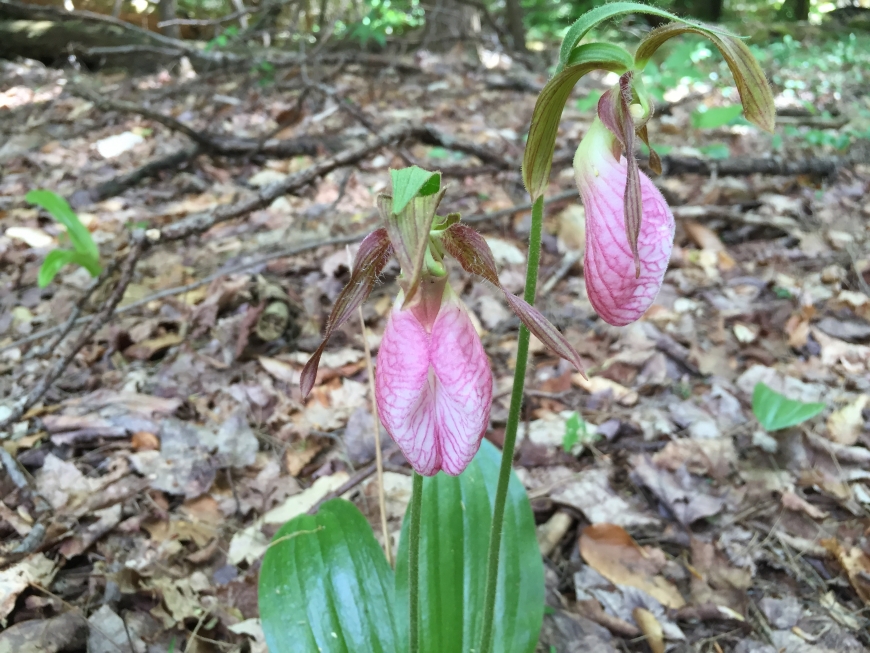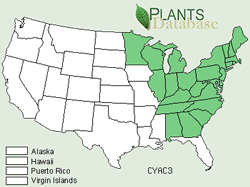

Pink lady's slipper on the Stone Valley Trail


Pink Lady’s Slipper: Too Precious to Pick
Pink lady’s slipper, or Cypripedium acaule, is a wildflower that belongs to the Orchid family and is known for its beautiful, bulbous, slipper-shaped blooms. As a child growing up in Maine I was taught to never touch—and especially not pick—these precious flowers. I fondly think back to hikes with my Girl Scout troop and remember how coming across a pink lady’s slipper was like finding a hidden natural treasure. We would all gather around the plant and revel in its beauty and mystery.
More recently, I encountered a few of these delicate pink lady’s slippers while hiking through Stone Valley Trail in Colton. I was reminded of my hikes as a young child and this time, I wanted to know more about this enigmatic flower. Read on to learn more about the pink lady’s slipper, and why we should protect these “lovely ladies” of the forest.
Pink lady’s slipper is a wildflower that typically grows on semi-acidic rocky and mossy ground in mixed hardwood forests. Pink lady’s slipper has two leaves that are opposite from each other at the base of its stalk, which is where the flower’s head emerges. According to USDA, pink lady’s slipper are found in the Northeast, Southeast, and parts of the Midwest. These brightly colored orchids bloom from May until July and tend to be around 6-15 inches tall. The flowers themselves are pink to whitish-pink and can sometimes have dark pink veins.

Range of the pink lady's slipper. Photo: USDA Plant Database
Pink lady’s slipper obtains its nutrients through a symbiotic relationship with fungi of the Rhizoctonia genus growing in the soil. Threads of fungus break open the seeds of the lady’s slipper and transfer its nutrients to the plant. Without the fungi’s assistance the pink lady’s slipper would not be able to reproduce. The fungus also benefits from this relationship with the pink lady’s slipper because it will take some of the nutrients from the well-established and healthy plant it has helped to create. Pink lady’s slipper serve as a food source for the Eastern forest snail as well as the white-tailed deer and provide shelter for many insects such as the common black ground beetle and the leopard slug.
Pink lady’s slipper is a tricky temptress to bees. Bees are attracted to the scent and bright pink color of the flower, but are then held at the mercy of the pink lady’s slipper for the flower’s benefit. The shape of their flower lures the bees inside of their slipper-like pouch, where they are then trapped in the pink lady’s slipper’s clutches. There is only one way out for the bees, by way of a narrow passage that contains small hairs underneath a mass of pollen. This ensures that any pollen from a different flower is brushed off before the bee exits, while simultaneously loading up the bee with its own pollen.
Pink lady’s slipper can grow to be around 50 years old (some species even can even survive for 100 years) - but it takes a lot of work to reach that age. These flowers take many years to mature as a plant because they do not produce their own nutrients (but instead receive the necessary nutrients through a symbiotic relationship with fungi).
Pink lady’s slipper has been used for medicinal purposes, which makes it important and useful to humans. The root of the plant can be used to remedy tooth pain and muscle spasms. In the 1800’s and 1900’s pink lady’s slipper (along with other orchids) were used for their sedative properties. Seeing as these plants are so fascinating, beautiful to look at, and can aid in pain management, many people have tried to transplant them - which has ultimately had negative results for the species. When the plant is dug up and transplanted, the unique relationship between the Rhizoctonia fungi and the plant is broken, which results in the destruction of the pink lady’s slipper.
In New York State pink lady’s slipper is considered “exploitably vulnerable,” and the USDA has deemed it illegal to pick or attempt to transplant these flowers on federal lands. In Maine, there have been reports of “orchid poachers” picking pink lady’s slipper plants for sale or transplant in their own garden. In addition, habitat loss due to human development has not helped matters for the pink lady’s slipper. Organizations such as the New England Wildflower Society have been formed to help protect and cultivate these rare and beautiful plants.
Pink lady’s slipper’s unique ecology, medicinal properties, and rare beauty make them fascinating inhabitants of our local forests. So the next time you are on a hike in the North Country and see a pink lady’s slipper, reach for the camera instead of reaching for the plant. Do not pick pink lady’s slipper or harm them in any way - instead, simply revel in all of the beauty and wonder they have to offer.

